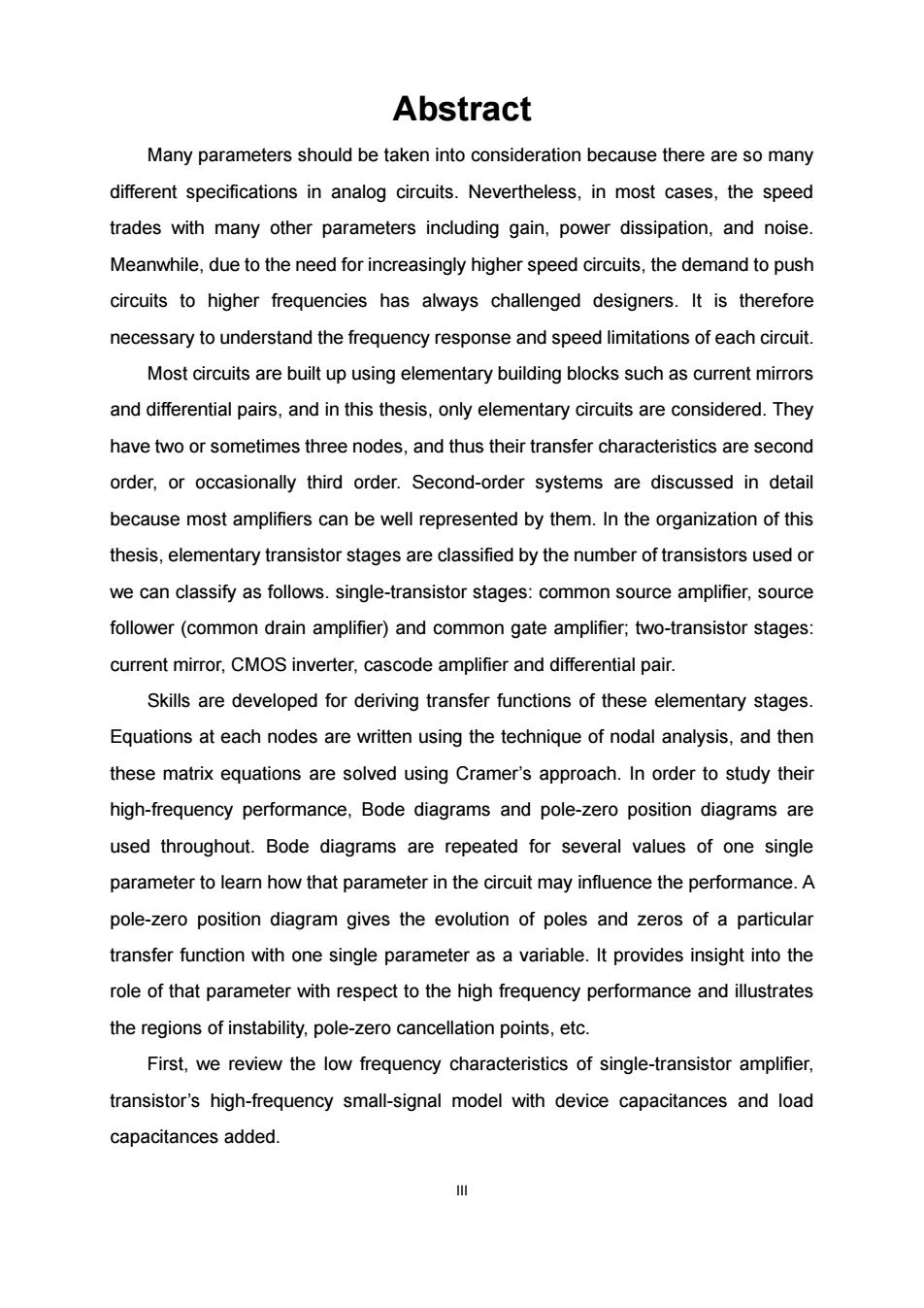正在加载图片...

Abstract Many parameters should be taken into consideration because there are so many different specifications in analog circuits.Nevertheless,in most cases,the speed trades with many other parameters including gain,power dissipation,and noise. Meanwhile,due to the need for increasingly higher speed circuits,the demand to push circuits to higher frequencies has always challenged designers.It is therefore necessary to understand the frequency response and speed limitations of each circuit. Most circuits are built up using elementary building blocks such as current mirrors and differential pairs,and in this thesis,only elementary circuits are considered.They have two or sometimes three nodes,and thus their transfer characteristics are second order,or occasionally third order.Second-order systems are discussed in detail because most amplifiers can be well represented by them.In the organization of this thesis,elementary transistor stages are classified by the number of transistors used or we can classify as follows.single-transistor stages:common source amplifier,source follower(common drain amplifier)and common gate amplifier;two-transistor stages: current mirror,CMOS inverter,cascode amplifier and differential pair. Skills are developed for deriving transfer functions of these elementary stages Equations at each nodes are written using the technique of nodal analysis,and then these matrix equations are solved using Cramer's approach.In order to study their high-frequency performance,Bode diagrams and pole-zero position diagrams are used throughout.Bode diagrams are repeated for several values of one single parameter to learn how that parameter in the circuit may influence the performance.A pole-zero position diagram gives the evolution of poles and zeros of a particular transfer function with one single parameter as a variable.It provides insight into the role of that parameter with respect to the high frequency performance and illustrates the regions of instability,pole-zero cancellation points,etc. First,we review the low frequency characteristics of single-transistor amplifier, transistor's high-frequency small-signal model with device capacitances and load capacitances added. 川III Abstract Many parameters should be taken into consideration because there are so many different specifications in analog circuits. Nevertheless, in most cases, the speed trades with many other parameters including gain, power dissipation, and noise. Meanwhile, due to the need for increasingly higher speed circuits, the demand to push circuits to higher frequencies has always challenged designers. It is therefore necessary to understand the frequency response and speed limitations of each circuit. Most circuits are built up using elementary building blocks such as current mirrors and differential pairs, and in this thesis, only elementary circuits are considered. They have two or sometimes three nodes, and thus their transfer characteristics are second order, or occasionally third order. Second-order systems are discussed in detail because most amplifiers can be well represented by them. In the organization of this thesis, elementary transistor stages are classified by the number of transistors used or we can classify as follows. single-transistor stages: common source amplifier, source follower (common drain amplifier) and common gate amplifier; two-transistor stages: current mirror, CMOS inverter, cascode amplifier and differential pair. Skills are developed for deriving transfer functions of these elementary stages. Equations at each nodes are written using the technique of nodal analysis, and then these matrix equations are solved using Cramer’s approach. In order to study their high-frequency performance, Bode diagrams and pole-zero position diagrams are used throughout. Bode diagrams are repeated for several values of one single parameter to learn how that parameter in the circuit may influence the performance. A pole-zero position diagram gives the evolution of poles and zeros of a particular transfer function with one single parameter as a variable. It provides insight into the role of that parameter with respect to the high frequency performance and illustrates the regions of instability, pole-zero cancellation points, etc. First, we review the low frequency characteristics of single-transistor amplifier, transistor’s high-frequency small-signal model with device capacitances and load capacitances added